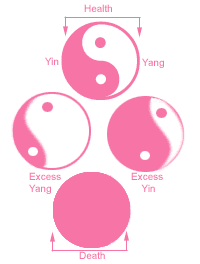|
Yin and Yang Theory
In Nature there are two equal and opposite
forces, for instance, Sun and Moon, Men and Women, Day
and Night, Heat and Cold etc. Balance among these forces is
essential. The same principle applies to our human body
as it is part of nature. The two energies consist of
Yin (negative) and Yang (positive)
which are in balanced state in a healthy person.
Whenever there is an obstruction to the flow of energy
or when there is deficiency or excess of energy in a
particular organ or if there is imbalance between yin
and yang factors, the person falls sick. By using
acupuncture needling, these obstructions can be
corrected.

Zang-Fu
Theory
There
are two categories of the organs associated with 12
organ meridians called Zang organs and Fu
organs.
Zang organs are negative and
solid organs having
storage functions. While fu organs are positive and
hollow organs having eliminative functions.
TRADITIONAL LAWS OF
ACUPUNCTURE
1.Mother-Son
Law
2.Midday-Midnight Law
3.Husband-Wife Law
4.Theory of Five Elements
These laws are a consideration of living interdependent dynamism of the body.
Mother-Son Law
If the lung meridian is empty, one should tone its mother, the liver. If the lung is full, one should disperse its child,
the large intestines. Mother-Son law can be applied to the law of five elements also. Thus if
the lung meridian is empty, one should tone its mother, the spleen and if lung is full, one should disperse its child, the kidney. Thus there are two alternative routes.
Midday-Midnight Law
Chinese people believe that each of the twelve
organ-meridian-function
complex has a period of two hours during which its activity becomes maximum. Chinese took therapeutic advantage of this. Thus
the liver has maximum activity from 1 A.M. to 3 A.M. and so any type of physiological, embryological or anatomical entities
which occur during this period are grouped under liver
. For e.g. Liver type of migraine.
This law can be used for diagnosis also.
If a meridian is deficient, it should be treated during the period of maximum activity.
If the meridian has excess, it should be treated after the period of maximum activity.
Husband-Wife
Law
This traditional Chinese law is based on the principle of pulse diagnosis. They believe that the disorders of the internal organs can be detected by the various pulse positions of
both the wrists.
Pulse are of two types-superficial and deep. In each wrist there are three superficial and three deep
pulse, making it twelve pulse in both the wrists for the twelve internal organs of the body. The superficial
pulse are of Yang in nature whereas deep pulse are Yin in nature.
Moreover it is said that the pulse of left wrist are husband in type and
pulse of right wrist are wife in type. As husband dominates wife, the
pulse of left wrist dominates the pulse of right wrist. The
pulse related to the
husband are-kidney, urinary bladder, liver, gall bladder, heart and small intestine. The
pulse associated with the wife are pericardium, triple warmer, spleen, stomach, lungs
and large intestines.
Theory of Five Elements
The traditional Chinese philosophy believes that the universe is basically made of five "elements" viz. wood, fire, earth metal, and water. A man is also a part of nature and hence he is also thought to be comprised of' the five "elements" of the universe.
In nature nothing exists as a single form and
separated from the other, indeed there is always some
influence of one over
the other in such a way that it becomes predominant. In Yin and Yang principle, Yin or Yang never exists separately but there is always some Yin component in Yang and Yang component in Yin.
Similarly the five elements cannot be separated from one another in a single subject but the nature of the subject depends on the predominance of the particular element.
The traditional Chinese medicine classified all
the internal organs of the body into two groups-"Yang" (Hollow) organs and "Yin" (Solid) organs and
accordingly, a particular "Yin" organ and a particular "Yang" organ
unite to fall in the regulation of universal law (couple organ).
In other
words, a particular Yin and Yang organ are related to a particular element of the universe. The five elements interact with each other to form a constructive or generative
(Sheng) cycle or interact in a destructive way to form a destructive
(Ko) cycle.
The "Qi" energy circulates among the different elements of the universe
to stabilize them and similarly it circulates in human body to make a balanced state (healthy). Any exogenous factor (hot, cold, humidity, virus, bacteria etc.) or endogenous factor (sorrow, fear, anger, shock etc.) may block the flow of vital energy and subsequently
the body is diseased.

|